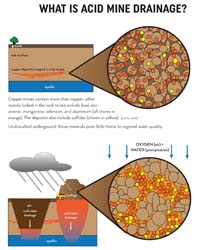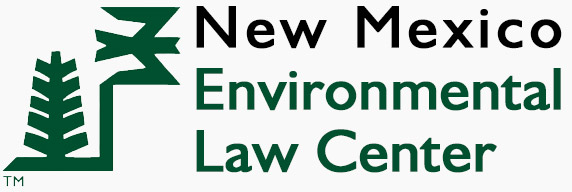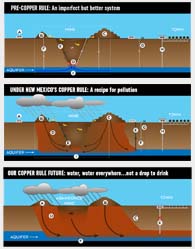Copper Rule Future

WHAT IS IT?
The Copper Rule is a set of regulations that govern water pollution by copper mines in New Mexico. The New Mexico Supreme Court has scheduled oral arguments to be heard on September 28, 2016 at 1:30 PM.
Get Complete Copper Rule info [PDF]
Who is challenging the Copper Rule and why?
The Copper Rule has been challenged by several entities since it was proposed in 2013. The groups listed below are concerned about the unprecedented decision by the State to give an entire industry license to pollute groundwater. If this Rule is allowed to stand, what is to prevent other industries from seeking a similar ‘license to pollute’?
The appellants in this case are:
- Amigos Bravos, a statewide water protection group based in Taos that works to protect surface water and groundwater quality in New Mexico.
- The Gila Resources Information Project (GRIP), based in Silver City, works to promote community health by protecting the environment and natural resources in southwest New Mexico.
- Turner Ranch Properties, whose Ladder Ranch is located adjacent to a proposed copper mine in Sierra County.
- William Olson, former Groundwater Bureau Chief of the New Mexico Environment Department (NMED).
- The New Mexico Attorney General.
The public-interest New Mexico Environmental Law Center is representing Amigos Bravos, GRIP and Turner Ranch Properties in the case before the Supreme Court.
SOME THINGS YOU SHOULD KNOW
Who wrote the Copper Rule?
In 2012, NMED established the “Copper Rule Advisory Committee” comprised of industry, public interest organizations and other stakeholders. The group was convened over 8 months to provide advice to the agency on the proposed Rule.
Agency technical staff drafted a compromise Rule that was submitted to the NMED Secretary and upper management. Shortly thereafter, the Rule was overhauled by NMED upper management, who stripped the proposed regulations of provisions that would protect water quality and public participation. Nearly all of the revisions to the draft Rule are found verbatim in the last round of comments submitted by Freeport-McMoRan (the world’s largest publicly-traded copper company, which owns and operates three mines in Grant County, NM). It was this industry “wish list” revised Rule that was presented to the WQCC in 2013.
After the WQCC adopted the Copper Rule, it came to light through an Inspection of Public Records Act request that Freeport-McMoRan authored NMED’s 220-page “Statement of Reasons” adopted by the WQCC when it adopted the Copper Rule. NMED had swapped its own 22-page Statement of Reasons for Freeport-McMoRan’s authored document, and passed it off as its own.
In a nutshell, what is the legal argument being presented to the New Mexico Supreme Court?
Appellants assert that the Copper Rule is in direct conflict with the state’s Water Quality Act, because “under [the Copper Rule], waste rock stockpiles, tailings stockpiles, and impoundments at all copper mines will intentionally be designed to cause groundwater pollution rather than prevent it. The Rule places no clear limit on the extent, duration, or type of groundwater pollution it would allow, and the Rule [permits] this pollution notwithstanding the fact that it is readily preventable through use of liners and other available means.” (From Appellants’ closing argument in Copper Rule rulemaking proceeding.)
Because the Rule illegally allows for the pollution of public groundwater that has present and future uses, Appellants are asking the Supreme Court to overturn the Copper Rule, and remand the Rule back to the Water Quality Control Commission (or “WQCC”, the entity that adopts water quality regulations in New Mexico) with instructions that a new Copper Rule cannot allow for the wholesale contamination of ground water.
What is “Acid Mine Drainage”? Is it dangerous?
When water (either groundwater, streams or rain) and oxygen (air) come in contact with materials disturbed by mining – pit walls, tailings, stockpiles, waste rock – it picks up sulfides and forms sulfuric acid. This acid then dissolves metals (including copper, lead, iron, arsenic, selenium, aluminum, and manganese) found in those materials, creating “acid mine drainage”. When acid mine drainage flows into streams, it kills aquatic life, including fish; when it contaminates aquifers, that water cannot be used for domestic, agricultural or industrial purposes without expensive treatment.

Chino Copper Mine Pond – Click to enlarge.
Photo courtesy Gila Resources Information Project.
One major problem with acid mine drainage is that, once started, it lasts until the source of pollution, i.e. a tailings pile, is depleted of its sulfides and metals – something that can take millennia to happen (Roman-era mines are still polluting water 2,000 years after operating). Copper mine sites can be extensive and cover thousands of acres. One of Freeport-McMoRan’s copper mines in Grant County, the Tyrone Mine, extends approximately 9 square miles. Prior to the adoption of the Copper Rule, Earthworks estimated that the Tyrone and Chino copper mines produce 2 billion gallons of contamination every year.
Under the Copper Rule, mining companies must contain and treat, in perpetuity, polluted groundwater at their mine sites. While it is likely that New Mexicans will rely on aquifers near Silver City (and other copper mining communities) for centuries to come, there is little likelihood that the companies that mine near these communities today will be here to clean up their pollution for centuries to come.

